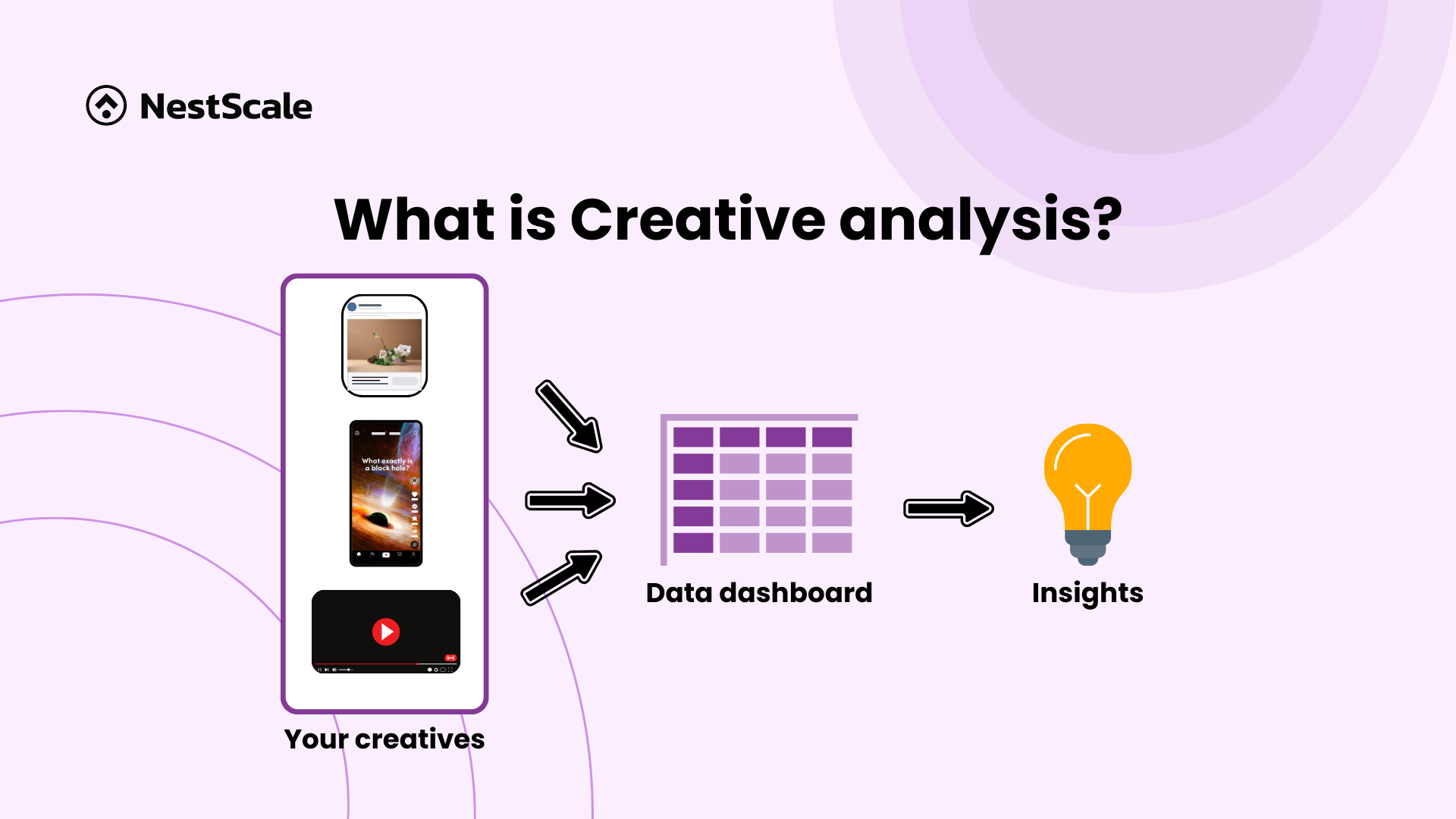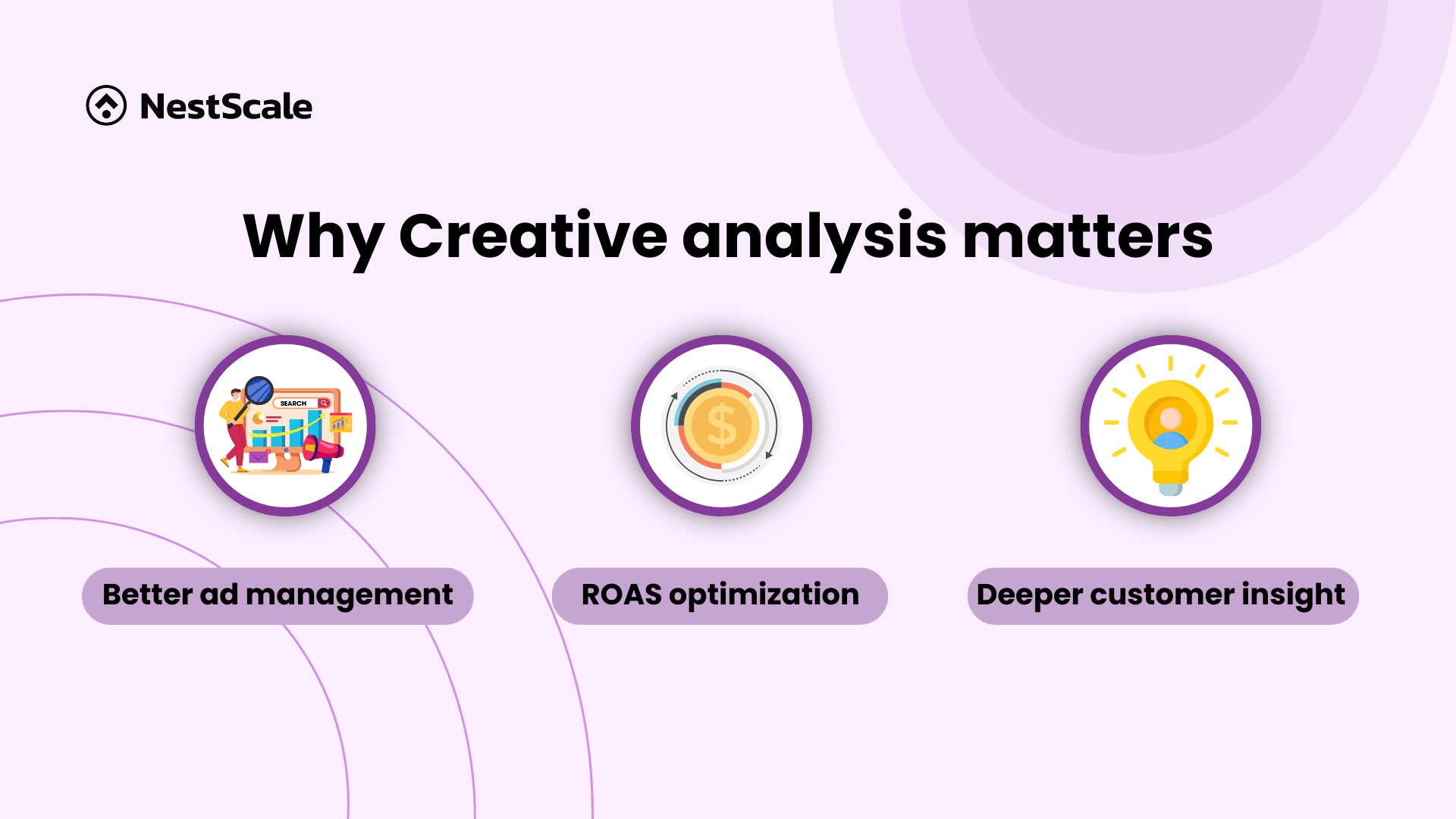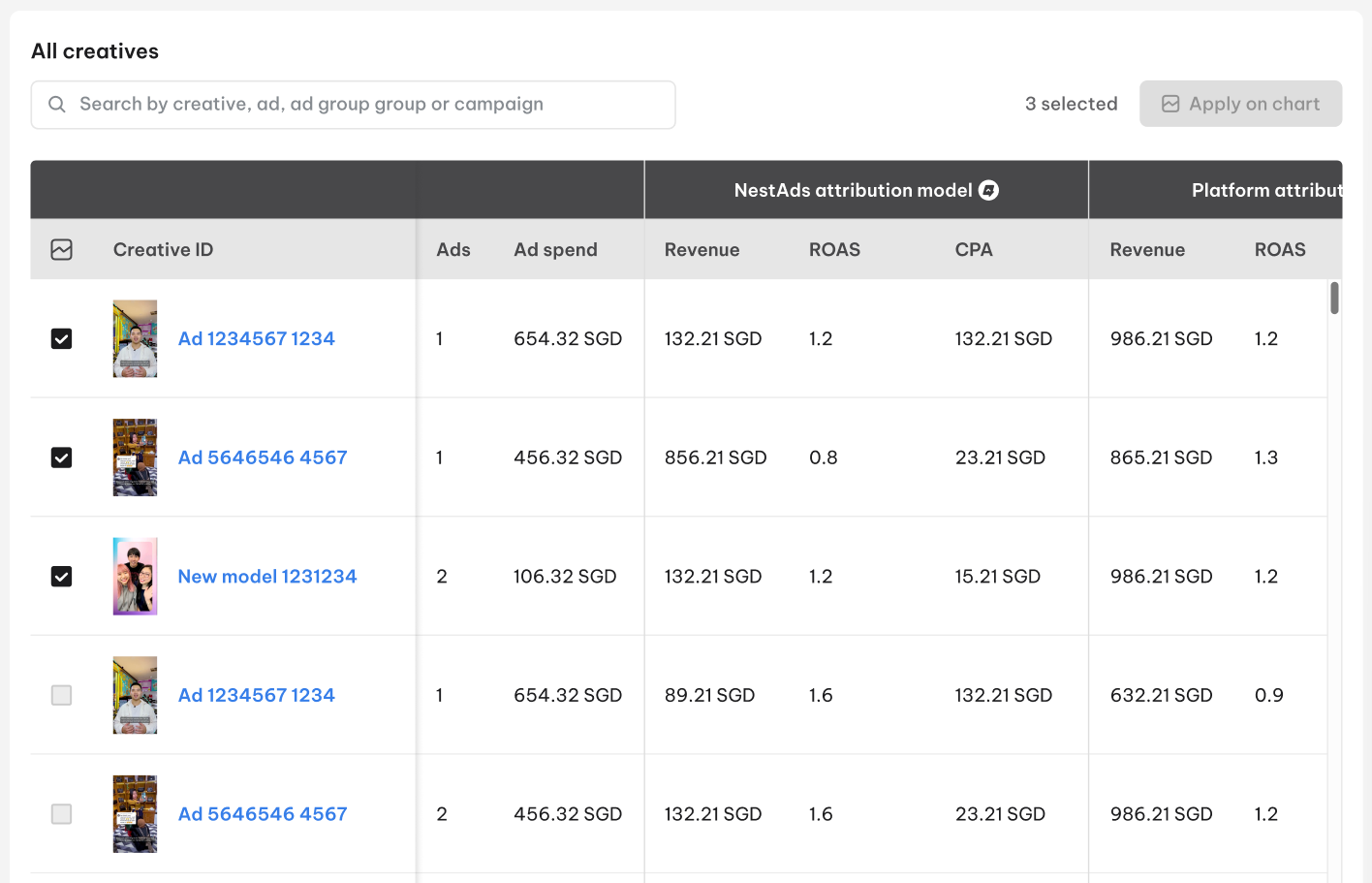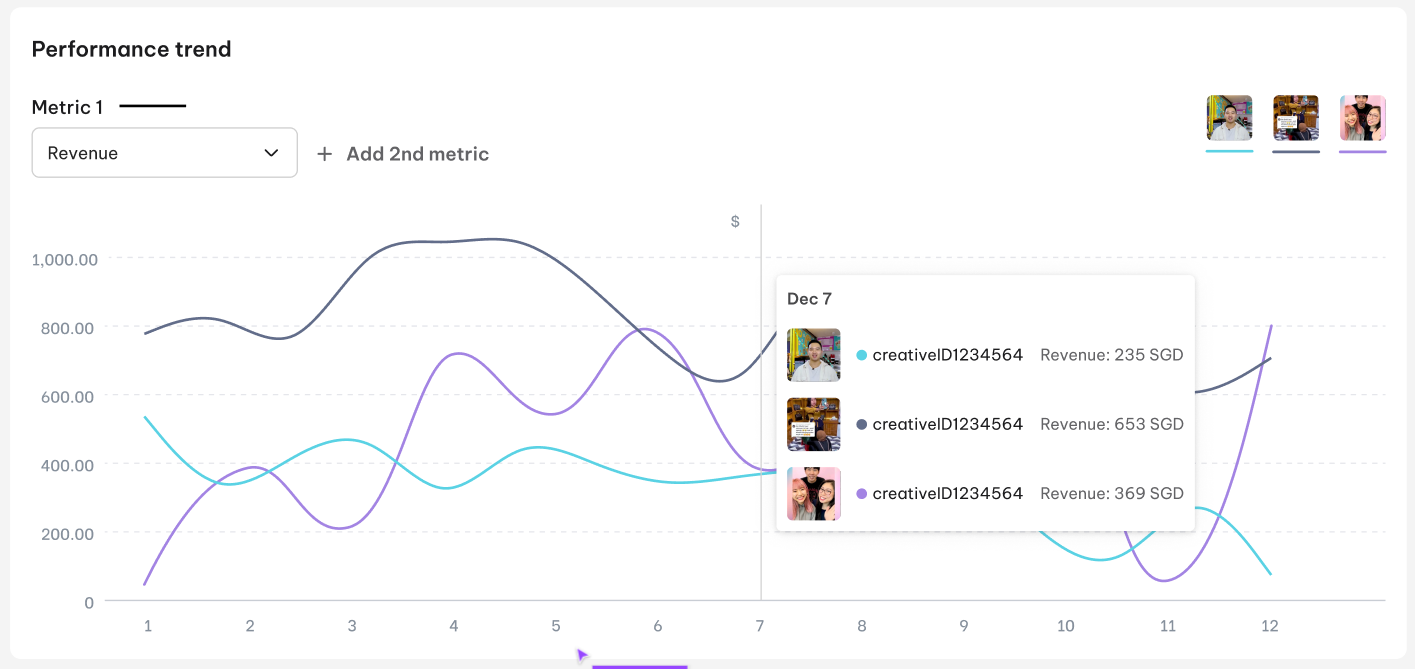Success in advertising isn’t just about having solid plans or targets. It’s also about focusing on the core element—your creatives. Therefore, delving deeper into each creative and conducting continuous analysis is crucial. This approach optimizes your advertising strategies and achieves the best possible return on investment.
In this blog post, we’ll explore what creative analysis is, why it matters, and how you can leverage it to boost your ad campaigns. We’ll share insights into the key metrics you should be tracking and the best practices for effective creative analysis to enhance your ad performance. So, without further ado, let’s get started!
What is Creative analysis?
Creative analysis is all about organizing and gathering data related to your ad creatives, like images, videos, ad copy, headlines, and call-to-actions. The aim is to figure out which creatives resonate best with your audience and encourage actions such as clicks, conversions, and purchases. Understanding how each type of creative performs helps you optimize your campaigns and allocate resources more effectively.

We cannot deny the importance of creative analysis. On targeting ad platforms like Facebook or TikTok, effective creatives can engage your customers and set you apart from competitors. However, it’s often overlooked when analyzing advertising performance because many advertisers focus on the usual ad-level metrics provided by these platforms. Moreover, analyzing creative performance involves more work, including experimenting with images, videos, and headlines, and using your intuition alongside the data.
However, with the right tools and techniques, creative analysis can be just as efficient and valuable as other forms of marketing analytics.
Why Creative analysis matters
You might wonder, “Isn’t monitoring my ads at the campaign, ad group, and ad set levels enough? Why dive deeper into my creative?” The answer lies in the profound impact that creative analysis can have on enhancing your overall strategy and performance:

Better ads management
Managing multiple ads with different creatives can be complex, especially when each creative serves various goals and targets distinct segments. Creative analysis streamlines this by identifying top performers across campaigns and ad sets, letting you focus on the most effective creatives.
It also simplifies updates; knowing which creatives work best helps you decide which to test and iterate. This alignment with specific objectives, like brand awareness, lead generation, or conversions, enhances overall effectiveness.
Optimize your ROAS
The ROAS is a critical metric for any e-commerce business. Creative analysis plays a vital role in optimizing ROAS by enabling efficient budget allocation towards high-performing creatives, thereby maximizing their reach and impact. This targeted approach ensures that your ad spend is directed toward ads that deliver the best results, enhancing overall efficiency.
Additionally, focusing on proven creatives minimizes the need for extensive experimentation, saving both time and money. This strategic allocation of resources reduces wasted ad spend on underperforming creatives and enhances retargeting efforts by providing insights into the most impactful ads, which effectively re-engage potential customers.
Deeper insight into your customers
Creative analysis offers data beyond basic performance metrics, providing insights into customer behavior and preferences. By evaluating which creatives perform better with different audience segments, you gain insights into various customer groups, helping tailor your messaging and creative elements to meet their needs.
This analysis also reveals types of content that resonate with your audience, whether it’s a particular visual style or format. Additionally, creative performance data can refine your understanding of customer personas, uncovering new insights into their motivations and preferences, enabling you to develop more targeted and personalized marketing strategies.
Key metrics for Creative analysis
We understand that tracking ad data across multiple platforms can be overwhelming. Therefore, if you do creative analysis, we suggest focusing on the most essential metrics. Based on our observations of eCommerce merchants, here are some key metrics you should look at:
- Click-through rate (CTR): CTR measures the percentage of people who click on your ad after seeing it. A high CTR indicates that your creative is compelling and relevant to your audience.
- Conversion rate (CVR): CVR tracks the percentage of clicks that result in a desired action, such as a purchase or sign-up. This metric helps you understand how well your creative drives conversions.
- Return on ad spend (ROAS): ROAS measures the revenue generated for every dollar spent on advertising. It’s a crucial metric for understanding the overall profitability of your campaigns.
- Cost per acquisition (CPA): CPA measures the cost of acquiring a new customer through your ad. Lower CPA values suggest that your creative is effective in driving cost-efficient conversions.
Techniques and tools to use for Creative analysis
Understanding how to make creative analysis more efficient and effective is essential when you’re starting out. In this section, we’ll guide you through some of the basics of creative analysis when first approaching this task:
Step 1: Consolidate your data
The first and most essential step in creative analysis is data centralization. You need to collect all the metrics for your ads and bring them together in one dashboard for easy monitoring. There are two techniques you can use: manual setup or using a creative analytics tool.
Manually set up with the spreadsheet
Yes, you can set up a creative analysis report using a basic tool like a spreadsheet. You can gather all metrics from the creatives running across different platforms and input them into your spreadsheet. Then, set up some formulas to calculate profit metrics for deeper insight.
The advantage of this method is that you can easily customize your report and the metrics you want to monitor. However, the downside is that it’s time-consuming to set up and gather the data, sometimes taking an entire day. Additionally, the data you collect might be less accurate. If these disadvantages make creative analysis sound daunting to you, there is another option you can consider.
Utilize the power of creative analysis tools
Using creative analysis tools can save you a lot of time when doing creative analysis. These tools centralize the data and perform calculations for you, making the analysis straightforward. Instead of spending hours on simple tasks, you can focus on delving deeper into your data. We recommend trying out NestAds – an effective option for all your ad analysis needs.

NestAds can help you overcome the drawbacks of manual setup and provide additional features to make your analysis more comprehensive:
- Centralize your data with insightful metrics: NestAds centralizes data from platforms like TikTok, Facebook, and Google, allowing you to compare creative performance across different channels in one place.
- Detailed creative reports: NestAds provides detailed reports that highlight the performance of each creative asset. You can easily identify which images, videos, and ad copies are driving the best results.
- Visualize customer journey: The platform uses centralized data to visualize the entire customer journey, helping you understand customer behavior and optimize the right creatives for the right channels.
- Comprehensive performance dashboard: The intuitive dashboard in NestAds makes it easy to visualize key metrics and trends, enabling you to quickly identify high-performing creatives and areas for improvement.
With NestAds, you have everything you need for your creative analysis, plus additional features, giving you a comprehensive view of how your store and marketing strategies are working together.
Step 2: Leverage your data insights
After gathering all your creative data, it’s time to utilize it and mine it for insights. Here is how you can do it:
- Identify high-performing creatives: Examine key metrics, such as CTR and ROAS, for all your creatives to pinpoint which ones bring profit to your store. Don’t just look at the overall metrics; also evaluate the performance of creatives across different platforms to identify which ones are most effective on each platform.
- Visualize the customer path: Next, put your creatives into the big picture. Map out the customer journey to see how different creatives influence each stage of the customer’s journey to your store. This provides a more targeted view for optimization.
- Track trends and adjust your strategies: Monitor the trends of your creatives over time and see which types your customers are engaging with the most. This helps you stay relevant and resonate with your customers.

Step 3: Optimize your ads for better ROAS
Optimizing your ads is crucial for maximizing the profitability of your advertising campaigns. A/B testing is one of the most effective techniques for achieving this. It allows you to compare different versions of your creatives to see which performs best. By testing variations of images, videos, ad copy, and call-to-actions, you can identify the combinations that drive the highest engagement and conversions.
Additionally, leveraging heatmap tools like Hotjar enhances your understanding of user behavior on your landing pages. These tools provide visual insights into where users click and scroll, helping you see how different creatives impact user interactions. By analyzing this data, you can make informed decisions about which creative elements are most effective at capturing attention and driving conversions.
Step 4: Diversify your creatives
Don’t rely on a single creative for your campaigns. Experiment with different formats, styles, and messages to see what resonates best with your audience. Diversifying your creatives helps you reach a broader audience and reduces the risk of ad fatigue. By continuously testing and introducing new creatives, you keep your ads fresh and engaging, maintaining audience interest and improving overall campaign performance.
Conclusion
Creative analysis is a powerful tool for optimizing your advertising campaigns and driving better results. By understanding the performance of your creatives and making data-driven decisions, you can improve targeting, enhance engagement, boost conversion rates, and maximize your ROI. Tools like NestAds provide valuable insights and features to help you analyze and optimize your creatives effectively.
Remember, the key to successful creative analysis lies in continuously monitoring, testing, and refining your strategies. By leveraging data and insights, you can ensure that your ad creatives resonate with your audience and drive meaningful results.
Additionally, if you have any questions or need further assistance, don’t hesitate to reach out to our team. We’re here to help you succeed in your digital marketing efforts.





















































